Lallart M. (ed.) Ferroelectrics - Physical Effects
Подождите немного. Документ загружается.

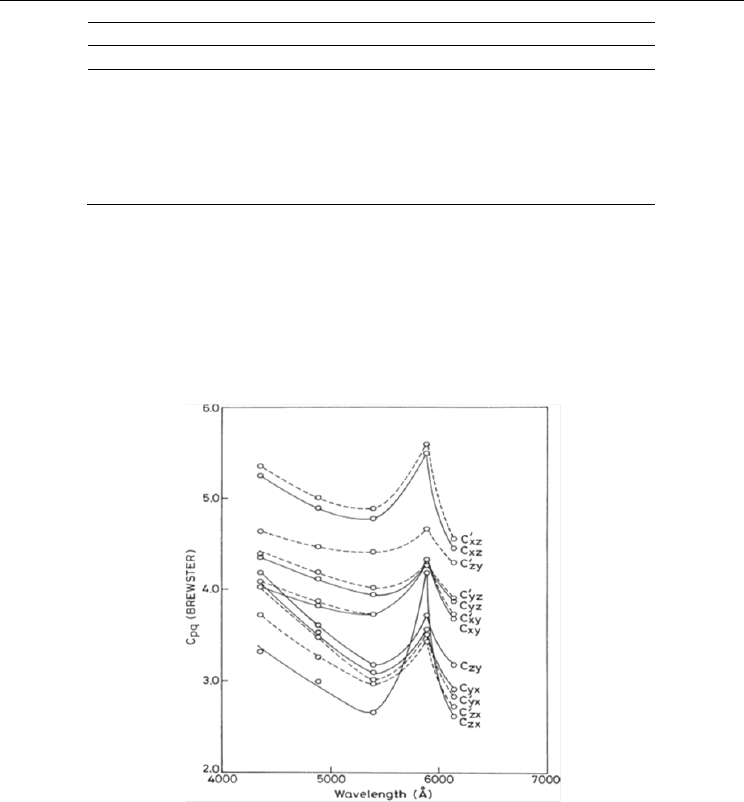
Piezo-optic and Dielectric Behavior of the Ferroelectric Lithium Heptagermanate Crystals
559
Wavelenghts
Obs. C
/
pq
4358Å 4880Å 5390Å 5890Å 6140Å
1 C
/
x
y
4.08 3.87 3.72 4.33 3.73
2 C
/
xz
5.35 5.00 4.88 5.59 4.55
3 C
/
y
x
4.02 3.47 3.01 3.50 2.83
4 C
/
y
z
4.39 4.19 4.01 4.26 3.90
5 C
/
zx
4.63 4.46 4.41 4.66 4.29
6 C
/
z
y
3.71 3.26 2.97 3.43 2.72
Table 2. Stress Optical Coefficients C
pq
(in Brewsters) for Li
2
Ge
7
0
15
(irradiated) at different
wavelenghts.
Some interesting results are obtained in the case of irradiated crystal LGO. The peak value
of C
/
zx
has decreased about 18% and that of C
/
zy
has increased about 25% at the wave length
λ= 5890 Å. Also, it is interesting to note that the value of C
6140
, is less than that of C
5390
for the
un-irradiated and irradiated sample of LGO crystal, in tune with usual observation of piezo-
optic dispersion.
Fig. 5. Stress optical dispersion of Li
2
Ge
7
0
15
crystals (un-irradiated and irradiated) with
Wavelength at room temperature (298 K).
Irradiation of crystals can change physical properties of the crystals. Irradiation brings about
many effects in the crystal such as creating defects, internal stress and electric fields etc.
These irradiation effects in turn are supposed to affect the physical properties of the
irradiated crystal as compared to un-irradiated crystal. While there was no appreciable
change in the lattice parameters, a significant drop in the value of dielectric constant and
tan δ was observed upon x-irradiation of ferroelectric glycine phosphate. An appreciable
shift in the phase transition temperature towards the lower temperature was observed.
These changes are attributed to the defects produced in it by irradiation (Vanishi & Bhat,
2005). The studies of triglycine sulphate (TGS) showed that very small doses of x-irradiation
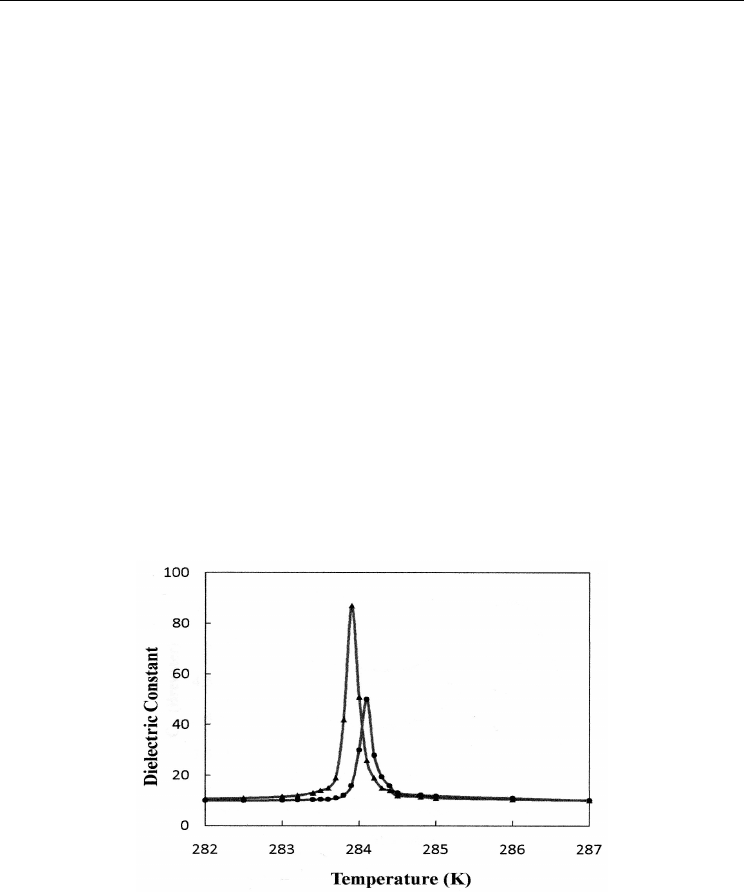
Ferroelectrics – Physical Effects
560
can give large changes of the ferroelectric properties. The direct evidence of domain
clamping by defects was obtained from optical studies. With increasing dosage the dielectric
constant peak and polarization curve broaden and move to lower temperatures. In our
present studies, the x-irradiation is believed to produce internal stress and electric fields
inside the crystals LGO due to defects that can change the values of piezo-optic constants
(Lines & Glass, 2004).
2. Dielectric property of lithium heptagermanate crystals
Lithium heptagermanate Li
2
Ge
7
O
15
(LGO) belongs to weak ferroelectric crystals and it has a
high nonlinearity of dielectric constant ε near T
c
. The curie-Weiss law holds only within a
narrow temperature interval close to T
c
with a small value of the Curie constant. This high
nonlinearity may be influenced by the external and internal electric field. The dielectric
permittivity has been shown (Wada & Ishibashi, 1983) to be sensitive to sample history, so
that reproducible results could be obtained only after a prolonged sample anneal at a
temperature substantially above T
c
. The nature of such behavior of ε is not clear.
2.1 Space charge effect in Li
2
Ge
7
O
15
crystals
An attempt is made to study the dielectric permittivity ε during the phase transition. The
plate-like specimens for the electrical measurements were polished and then silver
electrodes were deposited. The dielectric constants were measured along the c-axis at the
frequency of 1 MHz by means of a LCR meter (E7-12) in the temperature range from 298 K
to 273 K (Bain, 1994; Kudzin et. al., 1994, 1995).
Fig. 6. The temperature dependence of dielectric constant ε of Li
2
Ge
7
O
15
:0.7%Bi crystal at 1
MHz on cooling (▲) and heating (•) process.
Figure 6 shows the dielectric constant ε of Li
2
Ge
7
O
15
:0.7% Bi measured on cooling and
heating at 1 MHz as a function of temperature. It is found that the dielectric constant shows
a sharp peak around T
c
. The values at the peak are about 87 at cooling and about 50 at
heating. The function ε (T) is represented after the sample heating up to 290 K during about
an hour.
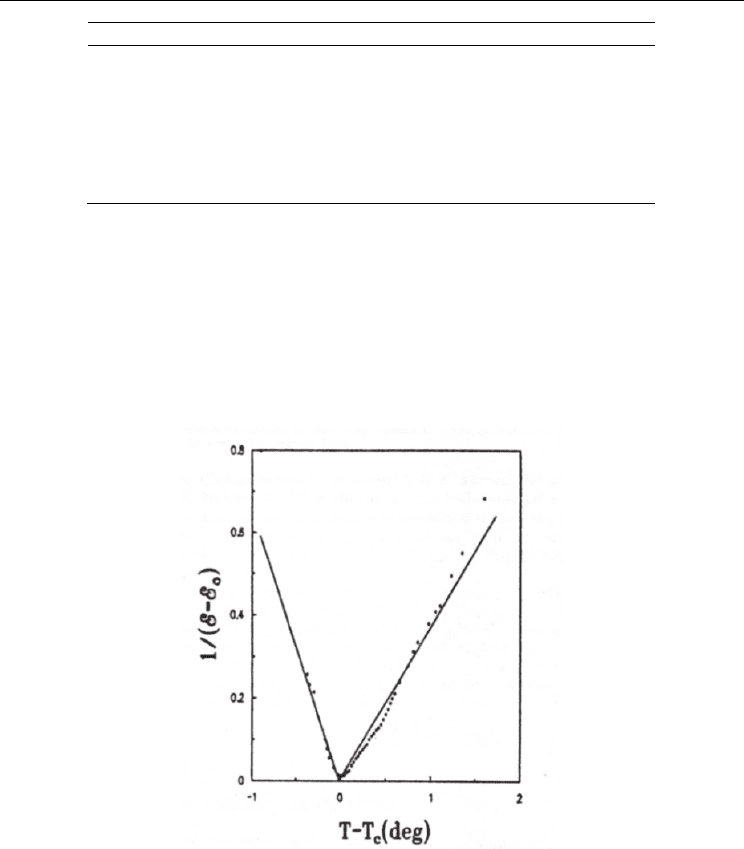
Piezo-optic and Dielectric Behavior of the Ferroelectric Lithium Heptagermanate Crystals
561
Sample ε
max
∆ε
max
∆ε
max
/ ε
max, %
LGO 74.9 19.9 26
LGO: 0.2%Bi 114.1 44.1 38
LGO: 0.3%Bi 120.18 49.73 41
LGO: 0.5%Bi 39.41 9.03 23
LGO: 0.7%Bi 87.19 37.42 42.9
LGO: 0.6%Eu 79.51 27.25 34
LGO: 0.3%Cr 9.86 1.62 16
Table 3. The relative change of ∆ε
max
/ ε
max
for Li
2
Ge
7
O
15
crystals and with different
percentage of impurity ions Bi, Eu and Cr.
The Curie-Wess plot of ε of Li
2
Ge
7
O
15
:0.7%Bi is shown in Figure 7, taking ε
0
as 7.1. It is
found that the Curie-Wess law holds only within a narrow temperature region around T
c
.
The Curie constant is about 2.6 K above the phase transition temperature and 1.3 K below
T
c
. The characteristic behavior of ε appeared substantially different from the value ε
max
,
which is obtained under the sample heating and cooling. The relative change of Δ ε
max
/ ε
max
for different percentage of impurity ions are shown in table. 3.
Fig. 7. The temperature dependence of reciprocal dielectric constant along the c-axis of
Li
2
Ge
7
O
15
:0.7%Bi on cooling. Solid line shows ε – ε
0
= C(T – T
c
)
-1
, where ε
0
= 7.1, T
c
= 283.9 K
and C = 2.6 K above T
c
, while C = 1.3 K below T
c
.
The dielectric constant ε is also measured at the frequency of 1 MHz at a constant electric
field. It is observed that the value of ε at T
c
decreases with the increase of constant electric
field during cooling and heating the sample and it is also observed that the difference
between two values of ε decreases at T
c
with the increase of constant electric field. Fig.8
shows the dielectric constant ε of Li
2
Ge
7
O
15
:0.7%Bi measured on cooling at 1 MHz as a
function of temperature for different values of constant electric field.
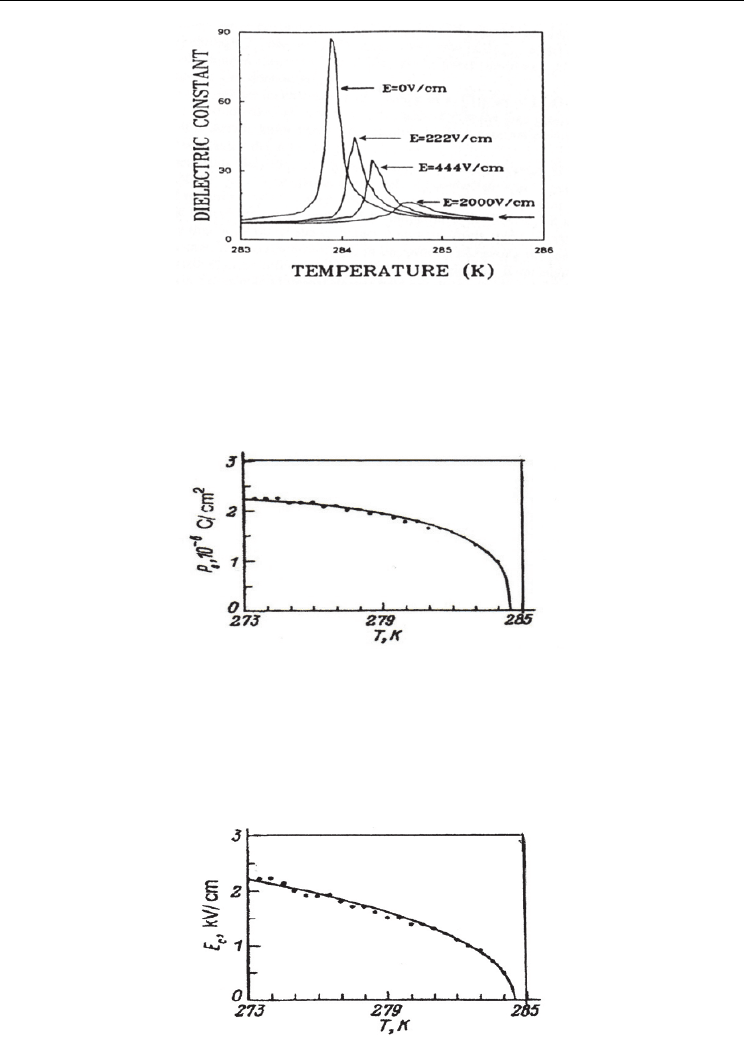
Ferroelectrics – Physical Effects
562
Fig. 8. The temperature dependence of dielectric constant ε of Li
2
Ge
7
O
15
:0.7%Bi at 1 MHz on
cooling for different values of constant electric field.
The spontaneous polarization P
s
and the coercive field E
c
were studied at 50 Hz by the well
known Sawyer-Tower technique. Both P
s
and E
c
were found to be independent of the
Bismuth ion concentration in Li
2
Ge
7
O
15
(within the concentration range investigated). The
temperature dependence of P
s
for Li
2
Ge
7
O
15
:0.7%Bi crystals is shown in Fig.9.
Fig. 9. Temperature dependence of the spontaneous polarization P
s
in Li
2
Ge
7
O
15
:0.7%Bi
crystals.
Under heating, spontaneous polarization first falls off slowly until ~280 K, then faster, and
vanishes at T
c
, without revealing a noticeable discontinuity. Fig.10 displays the temperature
dependence of the coercive field for Li
2
Ge
7
O
15
:0.7%Bi crystals. It is seen to fall off linearly
under heating up to ~280 K, then faster, to vanish at T
c
.
Fig. 10. Temperature dependence of the coercive field E
c
in Li
2
Ge
7
O
15
:0.7%Bi crystals.
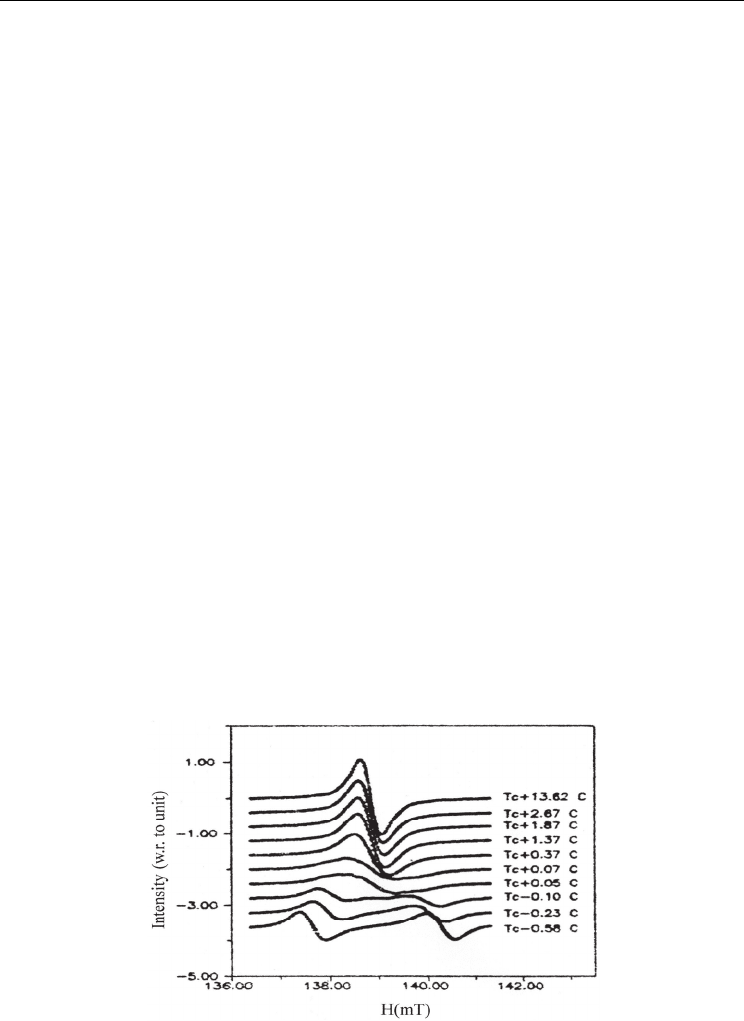
Piezo-optic and Dielectric Behavior of the Ferroelectric Lithium Heptagermanate Crystals
563
Domain structure may influence on the dielectric permittivity by means of two mechanisms.
1) The crystals that contain many domains are mechanically (piezoelectric) stressed. The
relation between dielectric permittivity at the mechanically stressed and at the mechanically
free state is given by (Nye, 1957)
ε
ε
3
– ε
σ
3
= d
2
33
c
E
33
(T = Constant) (2)
Here ε
ε
3
is the dielectric permittivity at the mechanically stressed state and ε
σ
3
is the
dielectric permittivity at the mechanically free state, d
33
is the piezoelectric modulus, and
c
E
33
is the modulus of elasticity at the constant electric field. This must cause the decrease of
ε in multi domain crystals. But the estimation shows that this mechanism does not allow to
explain the strong difference in ε
max
at T
c
. 2) The contribution to the dielectric permittivity
may give displacements of 180
0
domain boundary (Nakamura et al., 1984). Crystals of LGO
become multi domain near T
c
during heating the sample. After heating the sample only at 1-
2 K above T
c
and by subsequent cooling through T
c
, one obtains a very small value of Δε
max
,
as crystals of LGO are multi domain. So, basically it does not connect the hysteresis of
dielectric permittivity with domain structure.
There is another mechanism of the change of ε. Crystals of LGO have a small spontaneous
polarization, which becomes apparent in the high dielectric nonlinearity. It is already known
that a comparatively weak external electric field leads to the substantial decrease of ε
max
(Kholodenko, 1971). Experiments show (Volnyanskii et. al., 1992) that the crystals of LGO
are monodomain at the temperature T
c
– 10 K. The compensation of the field E
p
connected
with P
s
may take place by the redistribution of charges inside the crystals. These space
charges create an electric field inside the crystals, which compensates the field E
p
. It is
possible to assume that this field of space charges is comparatively stable (electret state). In
such a case, the decrement of ε
max
in the process of heating the sample may be connected
with the influence of internal field of electret. If we suppose that the effects of external and
internal electric field are the same, then the field of electret is ~ 160 V/cm.
Consecutive heating and cooling of a sample from the temperatures 293, 289.25, 285.5 and
284.5 K shows the value of ε
max
to decrease successively in the cooling runs while remaining
constant during heating. This supports the existence of an internal electric field in the
sample during the heating process.
Fig. 11. Temperature dependence of EPR lines of Li
2
Ge
7
O
15
:Cr
+3
crystals for |M|= ½ ↔3/2,
H
║a, H
┴
c near T
c
during cooling process.

Ferroelectrics – Physical Effects
564
The EPR (Electron Paramagnetic Resonance) spectroscopy of the transition metal ion doped
crystals of LGO (Mn
2+
, Cr
3+
) has also been studied both in Paraelectric (PE) and ferroelectric
(FE) phases in the temperature interval from 298 K to 279 K during cooling and heating
cycles (Trubitsyn et. al., 1992; Bain, 1994). It is observed that on approaching T
c
in a cooling
cycle, the EPR lines are slightly shifted to the high field direction and undergo substantial
broadening. At the temperature T
c
( ≈ 283.4 K), the EPR lines are splitted into two
components which are shifted to the higher and lower field directions progressively as a
result of cooling the sample below T
c
as shown in Fig.11.
During heating cycle (i.e. approaching T
c
from below), the phenomena occurred were just
opposite to the above processes observed in the cooling cycle. However, the EPR line width
(peak to peak ∆H
pp
) for H║c, H
┴
a was found to decrease to about one third of its value at T
c
in a heating cycle as compared to its value in the cooling cycle. The shape of the EPR
resonance lines far from T
c
has a dominant Lorentzian character (a Lorentzian line shape)
but very near to T
c
, the line shape has been described mainly by Gaussian form of
distribution (a Gaussian line shape). All the peculiarities observed are attributed to the PE ↔
FE phase transition of the LGO crystals. The line width reduction near T
c
is attributed to the
internal space charge (electret state) effects which produce an internal electric field inside
the crystals on heating process from the ferroelectric phase. This observation is similar to the
dielectric hysteresis behavior of the crystals LGO near T
c
.
2.2 Study of impedance in Li
2
Ge
7
O
15
crystals
The temperature dependence of a.c. electrical impedance (Z) was studied along the c-axis in
ferroelectric Li
2
Ge
7
O
15
(LGO) single crystals in 10 kHz – 10,000 kHz frequency range by
means of impedance analyzer (Agilent HP4294A) in the temperature interval from 298 K
to 273 K during cooling and heating process including T
c
= 283.5 K is shown in Fig 12 (Bain
et. al., “in print”). A rather temperature hysteresis of impedance is observed in a cooling and
heating cycle at T
c
= 283.5 K. The relative change of Δ|Z|
(min)
/|Z|
(min)
at the frequencies 100
kHz – 10,000 kHz is shown in Table 4. The relative change of Δ|Z|
(min)
/|Z|
(min)
is about
26% and it remains almost constant at the frequencies 100 kHz – 10,000 kHz. Here the value
of |Z|
(min)
= |Z|
room
– [|Z|
Tc
(on cooling)] and Δ|Z|
(min)
= [|Z|
Tc
(on heating)] – [|Z|
Tc
(on
cooling)].
Frequency
(kHz)
|Z|
(min)
( K-Ω) Δ|Z|
(min)
(K-Ω) Δ|Z|
(min)
/|Z|
(min)
, %
100 3.895 0.97 25.0
200 2.275 0.6 26.4
500 0.374 0.1 26.5
1,000 0.229 0.06 26.2
10,000 0.0224 0.0056 25.0
Table 4. The relative change of Δ|Z|
(min)
/|Z|
(min)
for Li
2
Ge
7
O
15
crystal at different
frequencies.
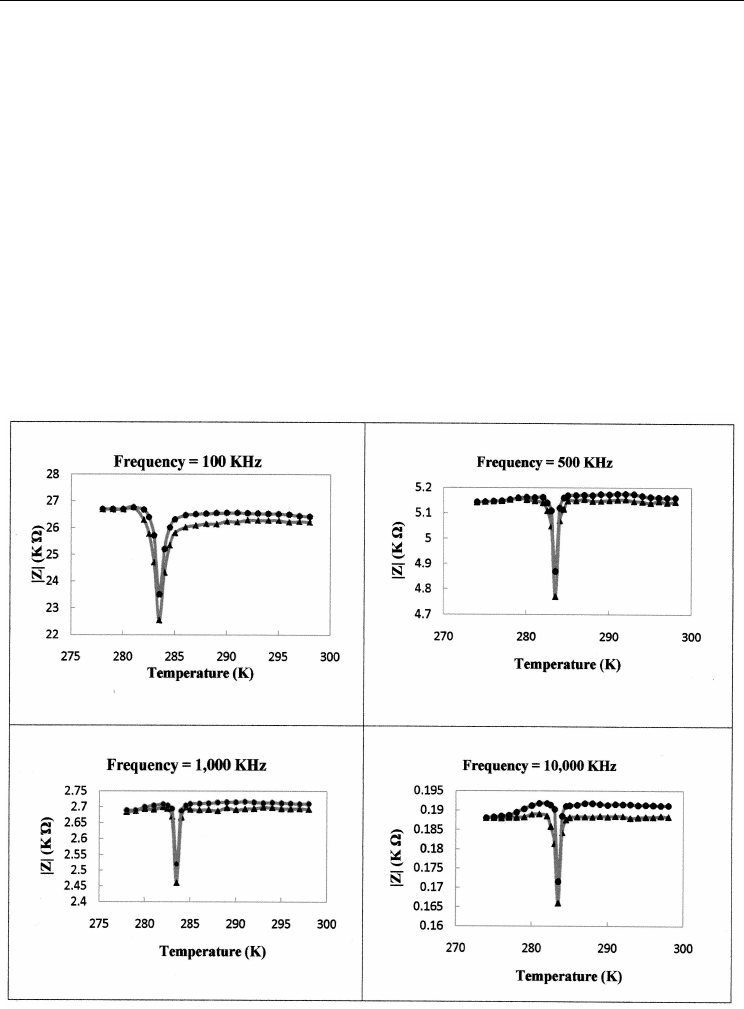
Piezo-optic and Dielectric Behavior of the Ferroelectric Lithium Heptagermanate Crystals
565
Like Fig.12, a similar kind of hysteresis was observed in the dielectric behavior of LGO, as
described in section 2.1 and the appearance of the dielectric hysteresis is attributed to the
internal space charge (electret state) effects which produce an internal electric field in LGO
on heating from the ferroelectric phase. It was possible to compensate the internal electric
field effects in dielectric measurements by an external electric field (Kudzin et al., 1994, 1995;
Bain, 1994). It is suspected that the impedance (Z) hysteresis also occurs due to similar
effects.
The frequency dependence of |Z| of the crystal LGO was studied in the temperature range
283.5 K to 573 K, which covers the phase transition temperature (T
c
) of 283.5 K as shown in
Fig.13. It is observed that the magnitude of |Z| decreases sharply with increasing of
frequency and tends to zero value at about the frequency of 10,000 kHz. This may be due
to the release of space charges. The curves also display single relaxation process and
indicate an increase in a.c. conductivity with frequency. So, in the application point of
view, LGO is suitable for conductivity even at the room temperature and frequency
controlled switch.
Fig. 12. The temperature dependence of a.c. impedance (ǀZǀ) of Li
2
Ge
7
O
15
at 100 kHz, 500
kHz, 1,000 kHz and 10,000 kHz on cooling(▲) and heating(•) processes.
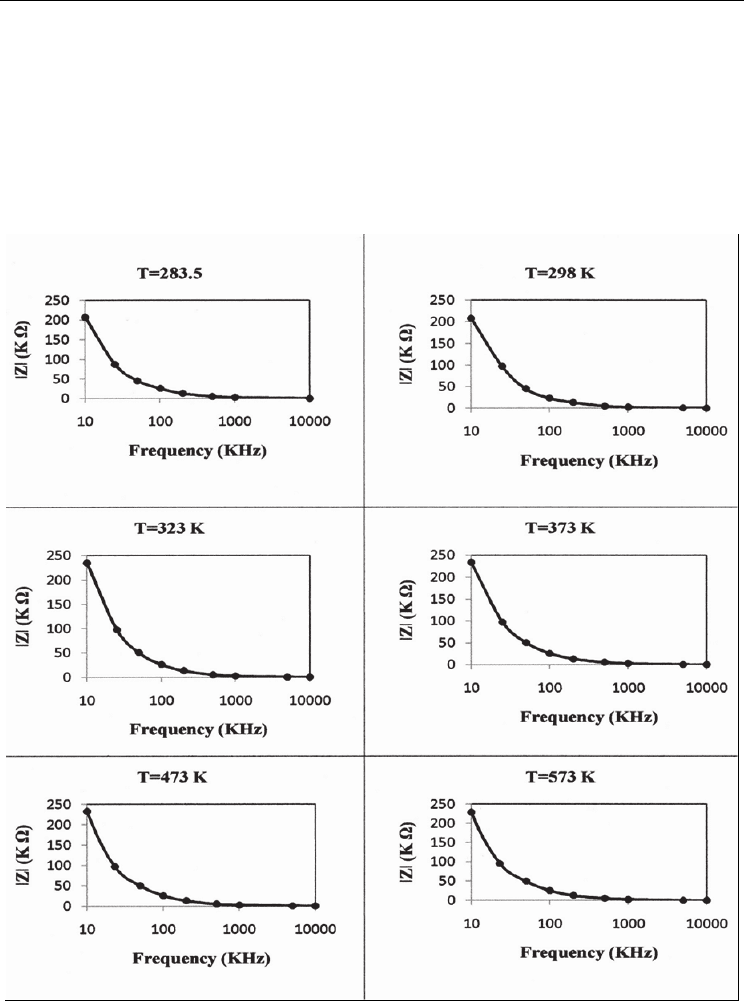
Ferroelectrics – Physical Effects
566
Fig.14 shows the temperature dependence of impedance |Z| of the crystal LGO at
frequency range 100 kHz – 10,000 kHz. It is observed that the value of impedance |Z|
decreases gradually with increasing temperature. This may be related with the space charge
relaxation at low frequencies.
At low temperatures the conductivity is dominated by short range hopping of charge
carriers. Whereas at high temperatures, more space charges are accumulated at the electrode
interfaces and grain boundaries, thus resulting in a strong space charge relaxation (Kim et
al., 2002; James et al., 1999).
Fig. 13. The frequency dependence of impedance (ǀZǀ) of Li
2
Ge
7
O
15
crystal at the temperature
range 283.5 K to 573 K.
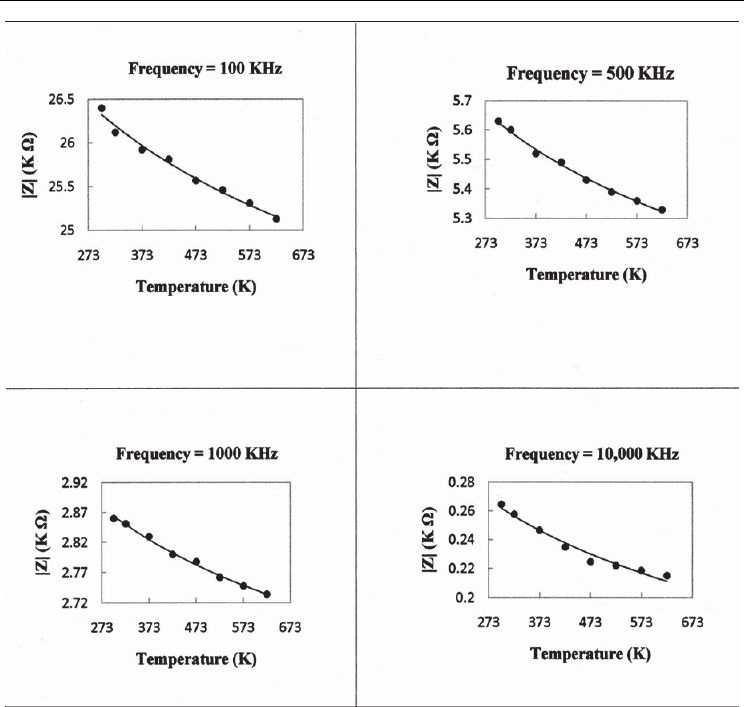
Piezo-optic and Dielectric Behavior of the Ferroelectric Lithium Heptagermanate Crystals
567
Fig. 14. Temperature dependence of impedance (ǀZǀ) of Li
2
Ge
7
O
15
crystal at Frequency range
100 kHz – 10,000 kHz.
3. Piezo-optic birefringence in Li
2
Ge
7
O
15
crystals
The temperature dependence of the photoelastic coefficients of the ferroelectric crystals
Li
2
Ge
7
O
15
in a cooling and heating cycle between 298 K and 273 K was carried out with the
experimental procedure described in section 1.4 (Bain et. al., 2009). A special arrangement
was made to vary the temperature of the sample. The temperature was recorded with a
digital temperature indicator and a thermocouple sensor in contact with the sample.
The temperature dependence of piezo-optic coefficients C
pq
of the crystals Li
2
Ge
7
O
15
between 298 K and 273 K were determined and are shown in Fig. 15 and Fig. 16. The values
of C
pq
at 291 K and 278 K were reported in paper (Bain et.al., 1998) and it was observed that
there were large changes in the values of C
zy
and C
yz
at 278 K and 291 K as compared to
other components and C
zy
did not show a peak in its temperature dependence between
291K and 278 K.
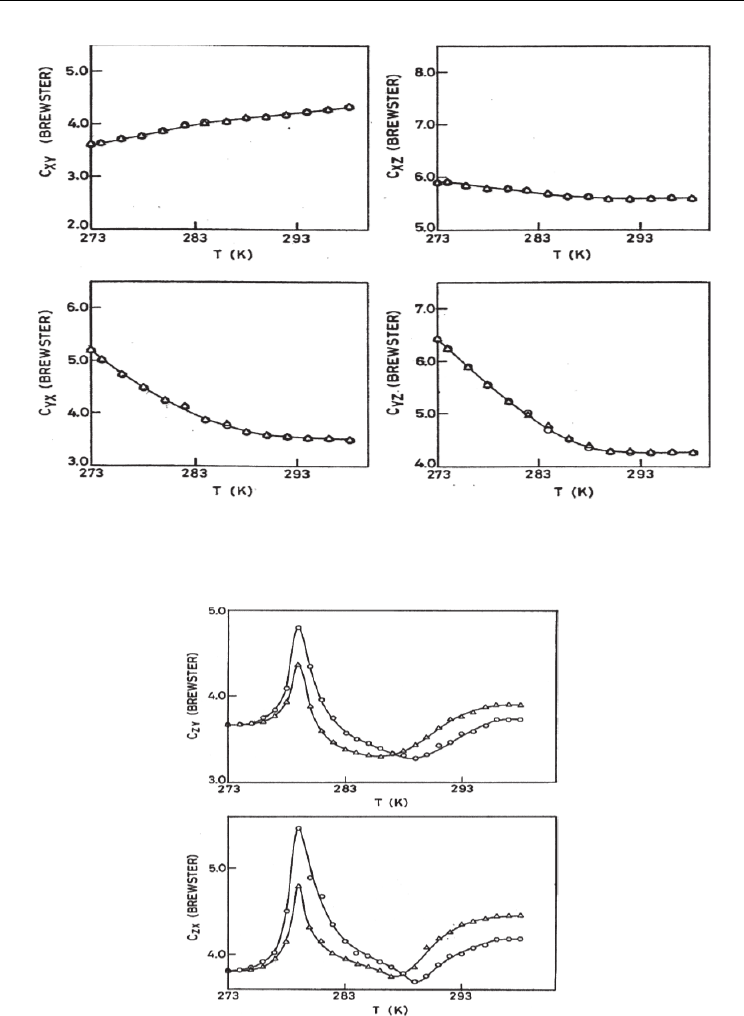
Ferroelectrics – Physical Effects
568
Fig. 15. Temperature dependence of the piezo-optic coefficients C
xy
, C
xz
, C
yz
and C
yx
of the
crystals LGO in a cooling (0) and heating (Δ) cycle.
Fig. 16. Anomalous temperature dependence of the piezo-optic coefficients C
zx
andC
zy
of the
crystals LGO in a cooling (0) and heating (Δ) cycle.
